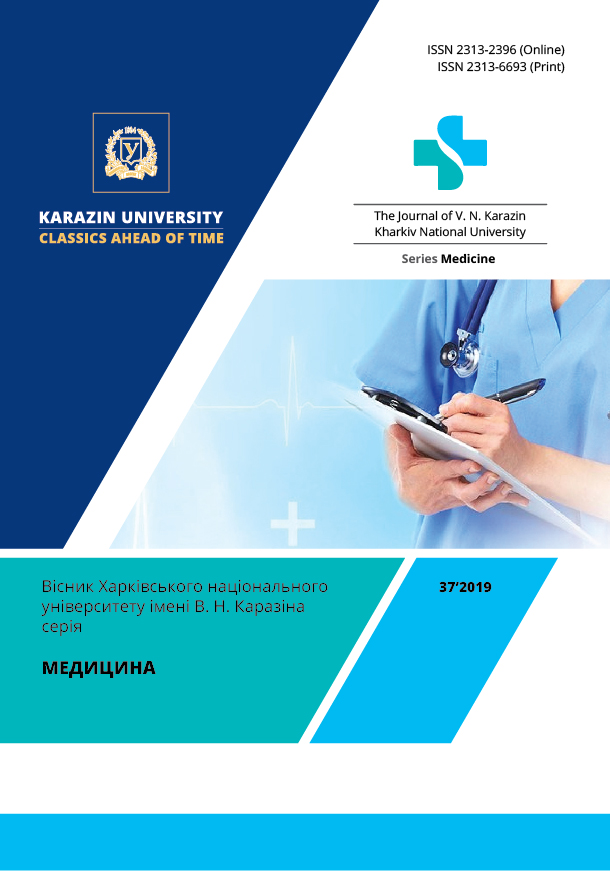Функціональний стан системи імунологічного захисту при травматичній хворобі у пацієнтів з підвищеним індексом маси тіла
Анотація
Вступ. Важливим резервом, що забезпечує процеси адаптації в системі імунорегуляції, є можливість різних її підсистем до перерозподілу структурно-функціональних зв’язків між ними. Підхід з позиції системного багатофакторного аналіза дозволить визначити основні функціональні взаємозв’язки, що виникають або порушуються в різні періоди травматичної хвороби у хворих з підвищеним індексом маси тіла (ПІМТ) при політравмі в імунній відповіді в цілому. Мета. Метою цього дослідження став аналіз функціонального стану системи імунологічного захисту при травматичній хворобі у пацієнтів з ПІМТ. Матеріали і методи. За допомогою системного багатофакторного аналізу визначалися інтегральні показники імуногенезу на підставі динамічного вивчення 1344 комплексних імунограм у 224 хворих з ПІМТ з політравмою та різною стартовою цифрою ІМТ. Пацієнти були розподілені на 3 групи: І група - 88 пацієнтів з ІМТ до 29,9 (26,1±3,1); ІІ група – 84 хворих з ІМТ до 30,0 - 39,9 (35,2±3,8); ІІІ група – 52 хворих з ІМТ >40,0 (46,2±5,8). Дослідження проводилося на 1, 3, 7, 14, 30 та 360 добу від моменту отримання політравми. Результати. В функціональному стані імунної системи в цілому у хворих з ПІМТ з політравмою були визначені певні закономірності: порушення імунореактивних процесів пролонговані до 1 року і більше з моменту отримання політравми не залежно від ІМТ, вони носять закономірний і односпрямований характер, мають періоди спаду і підйому активності; ступінь ушкодження, спроможність компенсаторних можливостей і здатність до їх відновлення залежить від ІМТ, так як первинні відхилення інтегрального показника практично однакові у всіх групах хворих; для пацієнтів І і ІІІ груп імунні механізми у всі строки більш за все визначаються станом клітинної ланки і системи комплементу. При цьому від ІМТ залежить механізм розвитку вторинного посттравматичного імунодефіцита, який пов’язаний із включенням подовженої Т-супресії і зниженням протягом більш ніж 14 діб концентрації IgA; у хворих групи ІІ була визначена чітка кооперація клітинних і гуморальних взаємозв’язків, яка направлена на компенсацію її наслідків, а також приєднання активної участі в імунних реакціях HLA-DR+ лімфоцитів як тонкого адаптаційного механізма. Через рік з моменту отримання політравми відбувався розвиток функціональної нестабільності системи переважно за рахунок Т-ланки. Висновки. Проведений нами аналіз дозволив об’єктивно на математичних моделях довести, що травматична хвороба – процес тривалий. Клініко-патогенетичні аспекти імунних порушень не викликають сумнівів і дають підставу для застосування запропонованих алгоритмів лікування і змінам стереотипів щодо підходу до лікуванню в цілому
Завантаження
Посилання
Gray, S., Dieudonne, B. (2018). Optimizing Care for Trauma Patients with Obesity. Cureus. 10(7). P. 2130.
Winfield, R.D., Southard, R.E., Turnbull, I.R., Bochicchio, K., Reese, S., Freeman, B.D., Bochicchio, G.V. (2015). Angiotensin Inhibition Is Associated with Preservation of T-Cell and Monocyte Function and Decreases Multiple Organ Failure in Obese Trauma Patients. J Am Coll Surg. 221(2). P.486–494.
Kornblith, L.Z., Howard, B., Kunitake, R. (2015). Obesity and clotting: Body mass index independently contributes to hypercoagulability after injury. J Trauma Acute Care Surg. 78(1). P. 30–36.
Chuang, J.F., Rau, C.S., Kuo, P.J. (2016). Traumatic injuries among adult obese patients in southern Taiwan: a cross-sectional study based on a trauma registry system. BMC Public Health. 16. P. 275–279.
Majdan, M., Brazinova, A., Wilbacher, I., Rusnak, M., Mauritz, W. (2015). The impact of body mass index on severity, patterns and outcomes after traumatic brain injuries caused by low level falls. Eur J Trauma Emerg Surg. 41(6):651–656.
Premaor, M. O., Comim, F. V., Compston, J. E. (2014). Obesity and fractures. Arq Bras Endocrinol Metabol. 58(5). P. 470–477.
Dhungel, V., Liao, J., Raut, H., Lilienthal, M.A., Garcia, L.J., Born, J., Choi, K.C. (2015). Obesity delays functional recovery in trauma patients. J Surg Res. 193 (1). P. 415–420.
Osborne, Z., Rowitz, B., Moore, H., Oliphant, U., Butler, J., Olson, M., Aucar, J. (2014). Obesity in trauma: outcomes and disposition trends. Am J Surg. 207(3) P. 387–392.
Вісник Харківського національного університету імені В. Н. Каразіна, серія Медицина має такі умови авторського права:
1. Автори зберігають авторські права та надають журналу право на першу публікацію разом із роботою, яка одночасно ліцензується згідно з ліцензією Creative Commons Attribution License, яка дозволяє іншим ділитися роботою з визнанням авторства роботи та першої публікації в цьому журналі.
2. Автори можуть укладати окремі додаткові договірні угоди щодо неексклюзивного розповсюдження опублікованої журналом версії роботи з підтвердженням її початкової публікації в цьому журналі.
3. Авторам дозволяється та заохочується публікувати свої роботи в Інтернеті до та під час процесу подання, оскільки це може призвести до продуктивного обміну, а також до раннього та більшого цитування опублікованої роботи.




